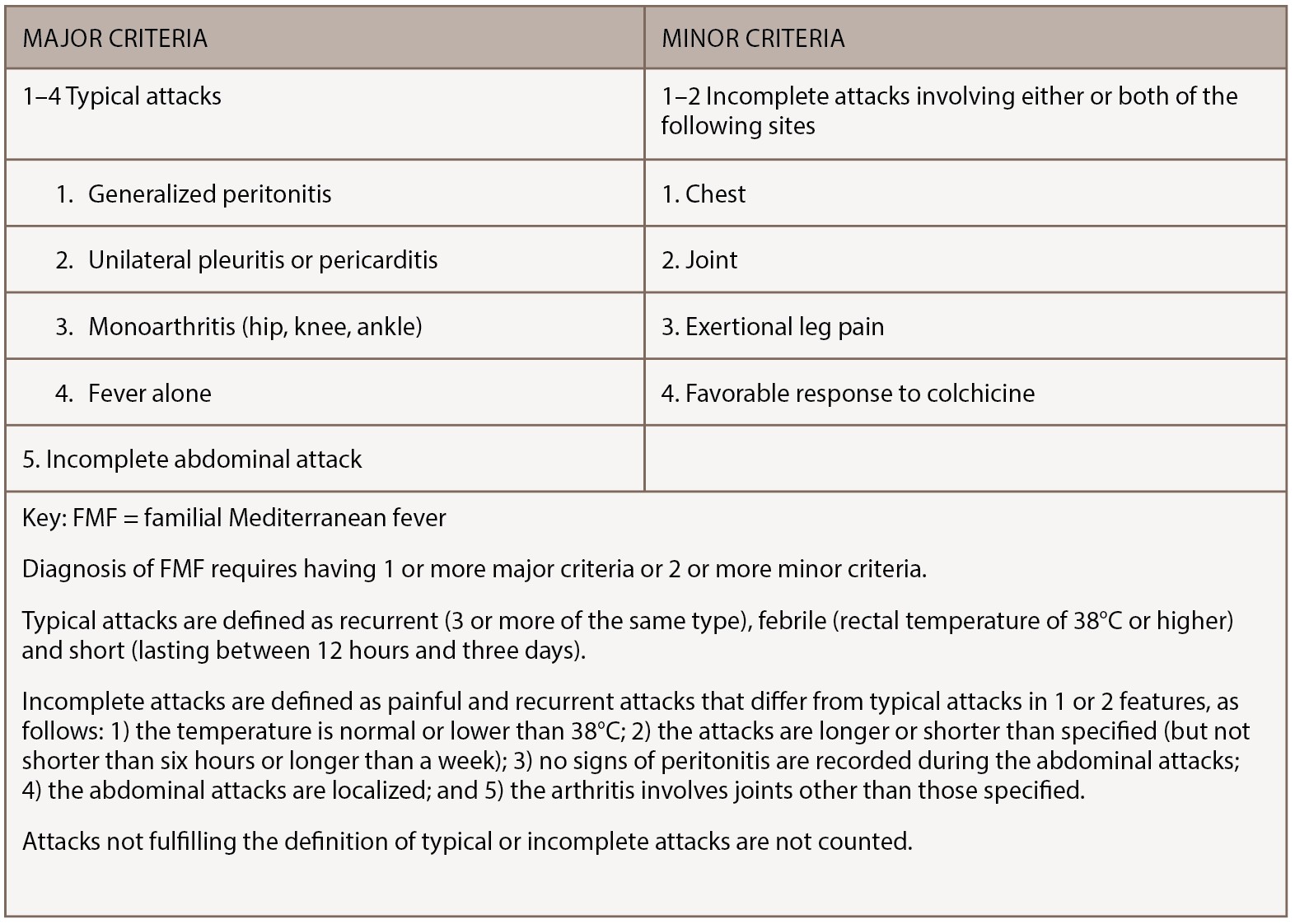Additionally, the K695R mutation, as well as multiple other clinically significant mutations in exon 10 (coding amino acids 577–781), alters the B30.2 domain, which interacts with caspase-1.11 This region is an important functional site for pyrin because it regulates the interaction with caspase-1. FMF mutations involving exon 10 represent a gain of function and, in a pro-inflammatory manner, enhance the interaction with caspase-1 to cleave precursor forms of IL-1β and, thus, unleash the inflammatory response and regulation of apoptosis.3 Pyrin also has an anti-inflammatory role, promoting autophagy of cytoplasmic regulators of innate immunity, eventually promoting the regulation of the inflammatory response.3
As noted, we started the patient on colchicine, and after several weeks he had a transient, partial response.
At his follow-up appointment after his diagnosis, we discussed alternative therapies should colchicine not control his symptoms, although the patient was encouraged to continue his colchicine for at least six months before considering it a therapeutic failure. If symptoms don’t sufficiently respond to colchicine, we may implement a trial of anakinra or a different IL-1 inhibitor. It has been observed that 5–10% of patients may not respond (or are intolerant) to colchicine, so close clinical monitoring for a durable response is important.3
Although this case highlighted many different teaching points to the rheumatologist providing his care, it was ultimately patience—on the part of both the patient and his doctor—along with telltale photos that led to his diagnosis.
 Taylor T. Faulk, MD, is an internal medicine resident at Keesler Medical Center at Keesler Air Force Base in Mississippi.
Taylor T. Faulk, MD, is an internal medicine resident at Keesler Medical Center at Keesler Air Force Base in Mississippi.
 Matthew B. Carroll, MD, FACP, FACR, is a practicing rheumatologist at the Singing River Health System in Pascagoula, Miss.
Matthew B. Carroll, MD, FACP, FACR, is a practicing rheumatologist at the Singing River Health System in Pascagoula, Miss.
References
- Ciccarelli F, De Martinis M, Ginaldi L. An update on autoinflammatory diseases. Curr Med Chem. 2014;21(3):261–269.
- Booty MG, Chae JJ, Masters SL, et al. Familial Mediterranean fever with a single MEFV mutation: Where is the second hit? Arthritis Rheum. 2009 Jun;60(6):1851–1861.
- Manukyan G, Aminov R. Update on pyrin functions and mechanisms of familial Mediterranean fever. Front Microbiol. 2016 Mar 31;7:456.
- Pras M. Familial Mediterranean fever: From the clinical syndrome to the cloning of the pyrin gene. Scand J Rheumatol. 1998;27(2):92–97.
- Livneh A, Langevitz P, Zemer D, et al. Criteria for the diagnosis of familial Mediterranean fever. Arthritis Rheum. 1997 Oct;40(10):1879–1885.
- Booth DR, Gillmore JD, Lachmann HJ, et al. The genetic basis of autosomal dominant familial Mediterranean fever. QJM. 2000 Apr;93(4):217–221.
- Aldea A, Campistol JM, Arostegui JI, et al. A severe autosomal-dominant periodic inflammatory disorder with renal AA amyloidosis and colchicine resistance associated to the MEFV H478Y variant in a Spanish kindred: An unusual familial Mediterranean fever phenotype or another MEFV-associated periodic inflammatory disorder? Am J Med Genet A. 2004 Jan 1;124A(1):67–73.
- Cekin N, Akyurek ME, Pinarbasi E, et al. MEFV mutations and their relation to major clinical symptoms of familial Mediterranean fever. Gene. 2017 Aug 30;626:9–13.
- Battal F, Silan F, Topaloğlu N, et al. The MEFV gene pathogenic variants and phenotype-genotype correlation in children with familial Mediterranean fever in the Çanakkale population. Balkan J Med Genet. 2017 Mar 5;19(2):23–28.
- Adzhubei IA, Schmidt S, Peshkin L, et al. A method and server for predicting damaging missense mutations. Nat Methods. 2010 Apr;7(4):248–249.
- Moradian MM, Babikyan D, Banoian D, et al. Comprehensive analysis of mutations in the MEFV gene reveal that the location and not the substitution type determines symptom severity in FMF. Mol Genet Genomic Med. 2017 Nov;5(6):742–750.



